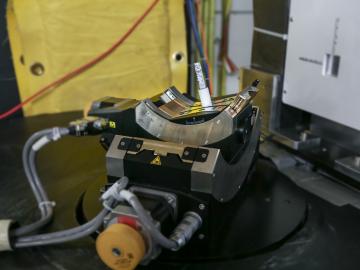
Filter News
Area of Research
- (-) National Security (24)
- (-) Neutron Science (127)
- Advanced Manufacturing (5)
- Biological Systems (2)
- Biology and Environment (71)
- Computational Biology (2)
- Computational Engineering (2)
- Computer Science (8)
- Electricity and Smart Grid (1)
- Energy Science (118)
- Energy Sciences (1)
- Functional Materials for Energy (2)
- Fusion and Fission (8)
- Isotope Development and Production (1)
- Isotopes (11)
- Materials (88)
- Materials for Computing (12)
- Nuclear Science and Technology (16)
- Quantum information Science (1)
- Sensors and Controls (1)
- Supercomputing (71)
News Topics
- (-) Artificial Intelligence (18)
- (-) Bioenergy (10)
- (-) Biomedical (16)
- (-) Energy Storage (8)
- (-) Neutron Science (120)
- (-) Security (12)
- (-) Space Exploration (3)
- 3-D Printing/Advanced Manufacturing (8)
- Advanced Reactors (2)
- Big Data (8)
- Biology (11)
- Biotechnology (2)
- Buildings (1)
- Chemical Sciences (5)
- Clean Water (2)
- Composites (1)
- Computer Science (31)
- Coronavirus (12)
- Cybersecurity (19)
- Environment (13)
- Exascale Computing (1)
- Fossil Energy (1)
- Frontier (2)
- Fusion (2)
- Grid (6)
- High-Performance Computing (6)
- Hydropower (1)
- Machine Learning (15)
- Materials (16)
- Materials Science (24)
- Mathematics (1)
- Microscopy (3)
- Nanotechnology (11)
- National Security (35)
- Nuclear Energy (7)
- Partnerships (5)
- Physics (10)
- Polymers (1)
- Quantum Computing (1)
- Quantum Science (8)
- Simulation (1)
- Summit (7)
- Transportation (7)
Media Contacts

Researchers at ORNL and the University of Tennessee, Knoxville, discovered a key material needed for fast-charging lithium-ion batteries. The commercially relevant approach opens a potential pathway to improve charging speeds for electric vehicles.

Oak Ridge National Laboratory researchers are developing a first-of-its-kind artificial intelligence device for neutron scattering called Hyperspectral Computed Tomography, or HyperCT.

When the COVID-19 pandemic stunned the world in 2020, researchers at ORNL wondered how they could extend their support and help

Scientists at ORNL used neutron scattering to determine whether a specific material’s atomic structure could host a novel state of matter called a spiral spin liquid.

To solve a long-standing puzzle about how long a neutron can “live” outside an atomic nucleus, physicists entertained a wild but testable theory positing the existence of a right-handed version of our left-handed universe.

ORNL scientists will present new technologies available for licensing during the annual Technology Innovation Showcase. The event is 9 a.m. to 3 p.m. Thursday, June 16, at the Manufacturing Demonstration Facility at ORNL’s Hardin Valley campus.

It’s a simple premise: To truly improve the health, safety, and security of human beings, you must first understand where those individuals are.

ORNL researchers used the nation’s fastest supercomputer to map the molecular vibrations of an important but little-studied uranium compound produced during the nuclear fuel cycle for results that could lead to a cleaner, safer world.

A team of researchers has developed a novel, machine learning–based technique to explore and identify relationships among medical concepts using electronic health record data across multiple healthcare providers.

Tackling the climate crisis and achieving an equitable clean energy future are among the biggest challenges of our time.


